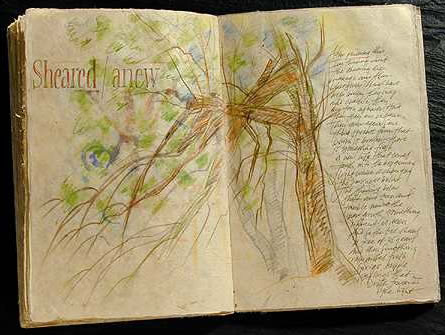
The real of the senses: a journey into the heart of the book, experience design and the librarian instinct of content.
I won’t pretend to be a scholar on this matter, let alone offering anything but the obvious. But this past week, working in Bend, speaking at the AdFed conference on advertising, design and web strategy, I found myself wandering back to some familiar ground.
The break came in talking about the concept of the journal. The journal, in my history as a creative. But the journal is more about the inward travel, the journey, than it is about the mere accumulation of text on a tattered, sewn gathering of pages. Actually, my talk was more about exploring the concept of the symbolic, the metaphoric in design.
To the concept of legacy of the journal, you can go two ways — one, to the daily travel, the journal that you are in your days, your wandering and your exploration. And two, the gathering alone — the journal is a collage of visual experiences and inspirations that might be something merely unto itself — another kind of journey.
There are etymological references, as well, that support this theoretical positioning. It’s not just me. It is what lies beneath.
Going back, in the string of the litany of linguistics, the history of the use, it’s about the day: journal, c.1355, “book of church services,” from Anglo-Fr. jurnal “a day,” from O.Fr. journal, originally “daily” (adj.), from L.L. diurnalis “daily” (see diurnal). Sense of “daily record of transactions” first recorded 1565; that of “personal diary” is 1610, from a sense found in French. Journalism, as a concept about daily “tracking” of news worthy content, is 1833 in Eng., likewise from Fr. (where it is attested from 1781).
And diurnal is just that, the day — but it is, too, about the light in that day; the spirit of the day, in a kind of godly revealing: c.1390, from L.L. diurnalis, from diurnum “day,” from L. diurnus “daily,” from dies “day” + –urnus, an adj. suffix denoting time (cf. hibernus “wintery”). Dies “day” is from PIE base *dyeu– (cf. Skt. diva “by day,” Welsh diw, Bret. deiz“day;” Arm. tiw; Lith. diena; O.C.S. dini, Pol. dzien, Rus. den), lit. “to shine” (cf. Gk. delos “clear;” L. deus, Skt. deva “god,” lit. “shining one;” Avestan dava– “spirit, demon;” Lith. devas, O.N. tivar “gods;” O.E. Tig, gen. Tiwes, (see Tuesday).
That journey, too, is every day — and that’s a story that can be told: c.1225, “a defined course of traveling,” from O.Fr. journée“day’s work or travel,” from V.L. diurnum “day,” noun use of neut. of L. diurnus “of one day” (see daily). As recently as Johnson (1755) the primary sense was still “the travel of a day.” The verb is from c.1330. Journeyman (1424), “one who works by day,” preserves the etymological sense. Its Amer.Eng. colloquial shortening jour (adj.) is attested from 1835.
What I’m referencing, in terms of my own life, is the idea that the journal became, during the college years — as a bench biologist — a kind of transformative tool; it lead from one sphere of exploration to another. I went from drawing cockroaches and marine biota, to thinking about the concepts of arrangement of content.
I’ve been preaching the concept of tiered content, the layering of story in reaching to readers. And the origin of that textual framing is something that winds itself far back to my roots, in arranging content, imagery, and the meander of how someone might access the formation — in idea.
So, these page structures are about exploring that idea how information can be layered in the geological strata of the journey into the mind of others. Or me.
That idea of the laying out, the laying of the page, the arrangement of text in imagery — they align and whirl. And they help — this book drops the storm — that is spinning round:
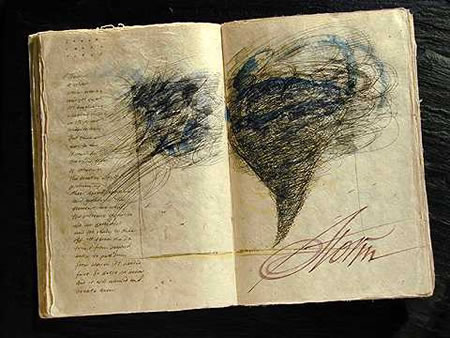
I lay in multiple columns, one after another, in being. Text, and paper, attached in a kind of sheathing, leveling the messaging:
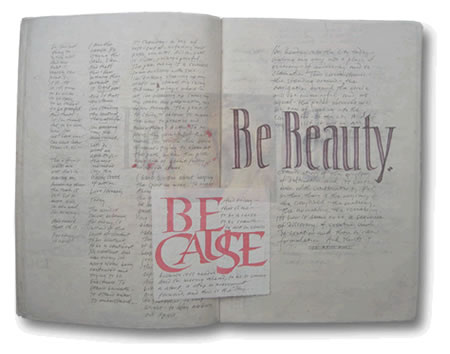
That big text, that tells that story, that reaches to another story, and column filters through the architecture of message:
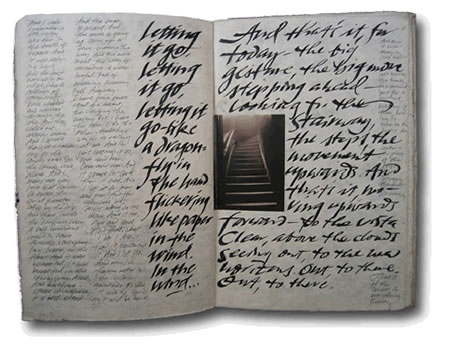
Text tucked, paragraphical insertions, initial rubric, the text filling the space, horror vacui, while the notion of sparked imagery.
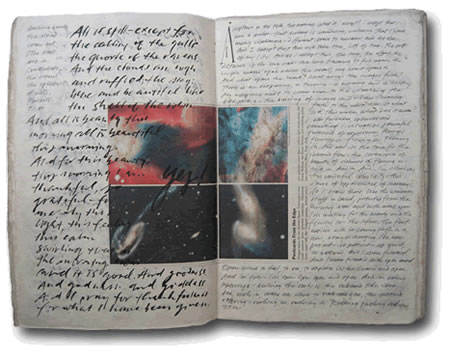
The words stream out, like a tapestry, layered on one, to another.
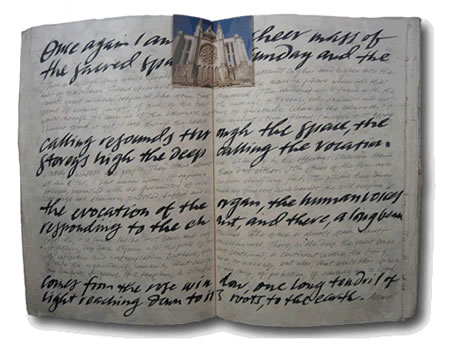
One message is just that. One:
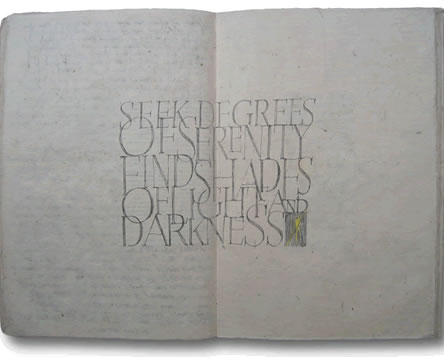
One word is hardly a word, but a page of messaging that is only about movement, gesture, swirling, knotting, concatenation — which is the nature of the movement of ideas.
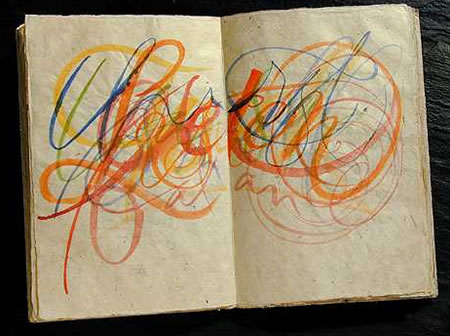
And then there are no words.
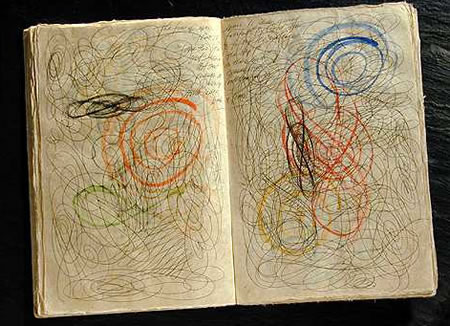
The real issue is the hand — and the touch of the hand, in eyes, in many levels of story, rippling down. But you can touch the page, you can smell the heat of the paper, the left over vestiges of the ink, the tinted wash of watercolor — which, in each color, can have a scent.
That idea is hardly new — the journey, the journal, the daily documentation, freshly found. I search for more, to the sensate voyage — the safari of the mind.
For example, this reference from friend Stuart Balcomb, that sparked part of this study — the touch of the book and what might be replacing it. The idea of the journal | journey, from hundreds of years back. These, from a knight on journey, wandering the chivalric pilgrimage. This reference, expressing: “‘Beschreibung der Reise von Konstanz nach Jerusalem’ [1487] (Description of a journey from Konstanz* to Jerusalem] records in diary form the pilgrimage undertaken by the German knight (as well as town mayor and architect), Konrad von Grünenberg.”


This document then is a pilgrimage journal — drafted by an itinerant artist, political figure and — in my legacy — designer. That idea of documentation of exploration — in one place or another — is profound, and seeming to be nearly a psychic link in experience; it’s a beautiful gathering, these collages of exploration. There’s more, here, to these individual journals — painting, sketches, text and observations.
Mapping, where one has been:
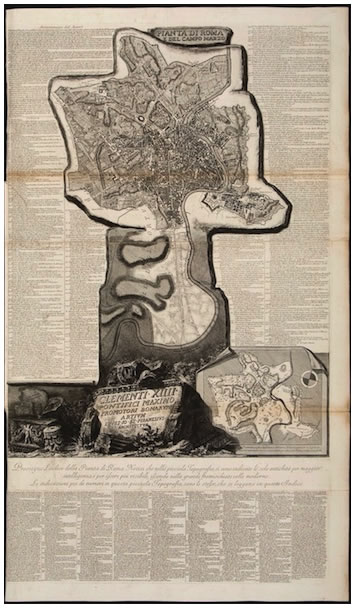
And there’s more, to explore, in the layering of the illustration, the shining of the idea. These from an exhibit, worth studying further.
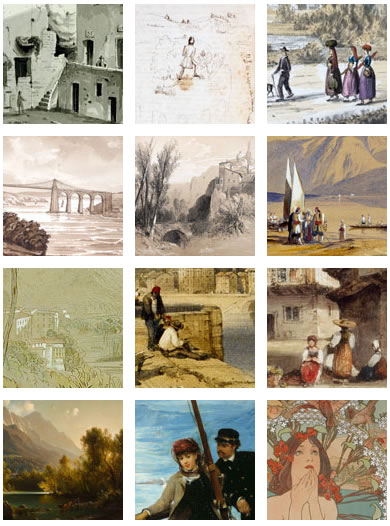
Personally, I savor that idea of the gathered imagery, in whatever format, even to the beauty of the large format photograph — more formal, but still important to a sense of reflection in the gathering of place, in memory.
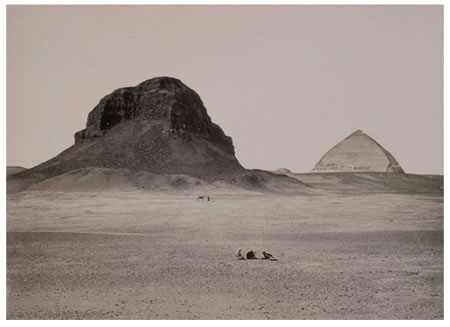
Francis Frith, English, 1822–1898, Albumen print The Pyramids of Dahshoor [Dahshur], from the East, from Egypt, Sinai, and Jerusalem: A Series of Twenty Photographic Views by Francis Frith, 1858, published 1860 or 1862
But, there’s another part to this notion of the blog on the book, the journal, the journey and the sensual implications of that connection — one, that speaks to my history in the exploration of these frames of touch, scent and sight — hearing; and two, the implications of Kindle. Finally, the third part of this combined examination — in my own mind, Google’s library of the future — a collection of books to last forever.
I can get to that. I’ve written about Kindle metaphorically, and there’s more about that to be coming, as another blog reference — a bigger study of symbolically motivated design.
I offer this. The beauty of Kindle lies in the character of the literature presented, accessibly — in a way that is beyond easy. But there’s another side to the study — touch and interface; there are two aspects. Touch and visualizations. I’ve touched them — and read them; and it’s different. It’s the power of the text, but it’s not the heart of the book, made in wholeness. The idea is really about what’s seen, holistically in scene, and held. Is that access worth the loss of touch? The scent and sight of the variable book — the many weighted tomes? Nicholson Baker summed the implications of revolution up nicely, in the following August 3rd rendering from the New Yorker. He proffered the following collective of comments, gathering observation:
“Everybody was saying that the new Kindle was terribly important—that it was an alpenhorn blast of post-Gutenbergian revalorization. In the Wall Street Journal, the cultural critic Steven Johnson wrote that he’d been alone one day in a restaurant in Austin, Texas, when he was seized by the urge to read a novel. Within minutes, thanks to Kindle’s free 3G hookup with Sprint wireless—they call it Whispernet—he was well into Chapter 1 of Zadie Smith’s “On Beauty” ($9.99 for the e-book, $10.20 for the paperback). Writing and publishing, he believed, would never be the same. In Newsweek, Jacob Weisberg, the editor-in-chief of the Slate Group, confided that for weeks he’d been doing all his recreational reading on the Kindle 2, and he claimed that it offered a “fundamentally better experience” than inked paper did. “Jeff Bezos”—Amazon’s founder and C.E.O.—“has built a machine that marks a cultural revolution,” Weisberg said. “Printed books, the most important artifacts of human civilization, are going to join newspapers and magazines on the road to obsolescence.”
Photography by Gus Powell, for the New Yorker
There are other components, though, to Nicholson Baker’s study that relate to my consideration — the screening of things. The notion of touch, of texture in the experience of learning being dissipated, over time, in the disappearance of the book. Possible? Not in the short term — but surely, it’s out there. What I wonder about is the nature of touch and experience that, first hand, (literally) links us to the sensuality of the book; with Kindle, you might say that this is gone. It’s a comment — that some might relate to, others perhaps not. Kindle looks like this: I’m not implying that the idea of a massing of portable digital books, your own walking library is anything less than a revolution in terms of content access. I do suggest that the feeling of, and with, and being in the books — live books, is a real component of sensual experience in reading.
Baker continues in an eloquence that’s quotable, to his exploration. I couldn’t have said it better:
“I tussled with a sense of anticlimax.
The problem was not that the screen was in black-and-white; if it had really been black-and-white, that would have been fine. The problem was that the screen was gray. And it wasn’t just gray; it was a greenish, sickly gray. A postmortem gray. The resizable typeface, Monotype Caecilia, appeared as a darker gray. Dark gray on paler greenish gray was the palette of the Amazon Kindle.
This was what they were calling e-paper? This four-by-five window onto an overcast afternoon? Where was paper white, or paper cream? Forget RGB or CMYK. Where were sharp black letters laid out like lacquered chopsticks on a clean tablecloth?”
Libraries are like that. And I’ve explored that idea earlier, the library, the mind, the allegory of memory. The palace of memory. The profound gathering character of the library does remind me of the conception of the mind, arrayed as a sense of place, in experience and recollection. The maximal ideas and the minutiae of the details are laid out here — an electrified string in magical meaning and storytelling, as in the reading exploratorium, the NYC Public Library, below.
In the considerations of the sequence of ideas, it starts with the opening observations — the spherical experience — the writing, the journal, the book that documents the live and the living. It’s a touching thing, a seeing thing, a scenting, a hearing; it leads you some place. Journal journey — the story of the hours, told.
That lends to a visioning of book in experience — and while Kindle offers a path to many layers of experience in reading and learning — the sensation is more to imagination than anything more physical.
What about the other crossover, from the digital book — or books — and the Google amassment strategy? Still too, there is value — as a recording. But this too might be a lessening of the physicality of sensual connection. Sergey Brin, Op-Ed Contributor at the NYTimes, a lover of the book — and their contents, offers some commentary on the nature of the book, the vanishing library, the disappearing old book store and the increasing evanescence of the tome: “Books written after 1923 quickly disappear into a literary black hole. With rare exceptions, one can buy them only for the small number of years they are in print. After that, they are found only in a vanishing number of libraries and used book stores. As the years pass, contracts get lost and forgotten, authors and publishers disappear, the rights holders become impossible to track down.”
There are other forms of dissolution, even recollecting his sense of history in personal literary loss “the few remaining copies of the books are left to deteriorate slowly or are lost to fires, floods and other disasters. While I was at Stanford in 1998, floods damaged or destroyed tens of thousands of books. Unfortunately, such events are not uncommon — a similar flood happened at Stanford just 20 years prior. You could read about it in The Stanford-Lockheed Meyer Library Flood Report, published in 1980, but this book itself is no longer available.”
Larry Page, the co-founder of Google values these links to the degree that it was more than a decade ago that he’d proposed the conception of digitizing all books. A task of such immeasurable complexity was not a successful attractor of talent to work on the project. Too big, how could it even be done? 2004, it was finally kicked off, and it has since accumulated more than 10 million volumes — and counting. While there are numberless challenges associated with the registration and literary rights management, there are issues attached to the calculated preservation of the books; it’s not the same experience — but the content, in every instance, is preserved.
Page’s study of the history of the “dissolution” of books, reveals “Cornelius Walford chronicles the destruction of dozens of libraries and millions of books, in the hope that such a record will “impress the necessity of something being done” to preserve them. The famous library at Alexandria burned three times, in 48 B.C., A.D. 273 and A.D. 640, as did the Library of Congress, where a fire in 1851 destroyed two-thirds of the collection.”
I suggest only the following, luxuriating in the realm of the sensualist — that books, as entities, are wholly different as sensical explorations — they guide, holistically, in a manner that is very involving, more so than the digital screen grab. While not denying the power of the fire of Kindle, or the gathering waves of the Google’s digital global book archiving role, the touch sense is whole — it reaches deep into the psychic place of larger imagining, empowering the physical place of rich imagining.
Hold a book, in this meaning.
TSG
Exploring brandstorming:
brandquesting® | http://blog.girvin.com/?p=733
Twitter: http://twitter.com/tgirvin